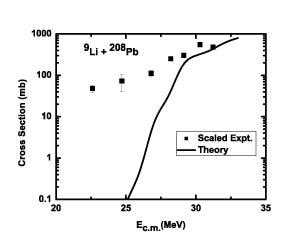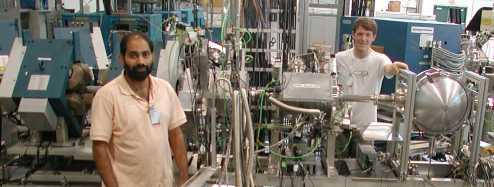
A group from Oregon State University (Loveland, Vinodkumar, Sprunger, Prisbrey and Neeway) and the University of Notre Dame (Kolata, Roberts, and Spencer) ran subatomic experiment S1126 at TRIUMF from July 11th to the 24th, attempting to measure the fusion excitation function for the 9Li + 208Pb reaction.
Recently this group performed a study (S1023)of the fusion of 9Li with 70Zn at ISAC. The results of this study (which has
A group from Oregon State University (Loveland, Vinodkumar, Sprunger, Prisbrey and Neeway) and the University of Notre Dame (Kolata, Roberts, and Spencer) ran subatomic experiment S1126 at TRIUMF from July 11th to the 24th, attempting to measure the fusion excitation function for the 9Li + 208Pb reaction.
Recently this group performed a study (S1023)of the fusion of 9Li with 70Zn at ISAC. The results of this study (which has been published in Phys. Rev. C) showed a large sub-barrier fusion enhancement for the reaction of 9Li with 70Zn that was not accounted for by current models of fusion.
If the results of the 9Li + 70Zn measurement are "scaled" to the 9Li + 208Pb reaction and compared to theoretical predictions for the fusion of 9Li with 208Pb (see Figure), one can see that the predicted sub-barrier fusion enhancement of 9Li + 208Pb is not anticipated.
The 9Li + 208Pb fusion excitation function is being measured by detecting evaporation residues (EVRs) from the fusion reaction that stopped in the 208Pb target. The EVRs are detected by α-particle spectroscopy using an 18 detector Si array that surrounds the target. The detected activities are 212, 213At, nuclides that are counted in the dead time between bursts of the chopped beam. The detection system was calibrated by observing these same residues from the 7Li + 209Bi reaction, where their yields are well known.
According to the group, the TRIUMF operations staff did a marvelous job of producing beams of 9Li at intensities of 5-10x106 p/s, that exceed the production rates observed in previous experiments. Measurements are being carried out at beam energies of 25, 27.5, 30, 32.5, 35, 37.5, 40, 42.5 and 45 MeV using ISAC-II.
Preliminary on-line analysis of the data shows significant sub-barrier fusion cross sections at energies (Ecm=26.4 MeV) below the nominal Bass barrier for the reaction (Ecm=29.1 MeV). There may even be detectable but low cross sections at Ecm = 24 MeV (see Figure).

